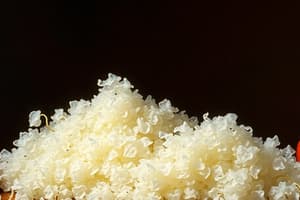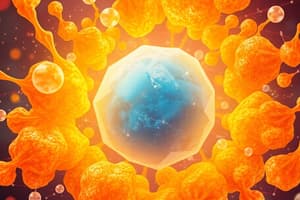Podcast
Questions and Answers
Which is the world's chief source of food carbohydrate?
Which is the world's chief source of food carbohydrate?
- Chitin
- D-glucose
- Starch (correct)
- Cellulose
What is the most common monosaccharide subunit in food polysaccharides?
What is the most common monosaccharide subunit in food polysaccharides?
D-glucose
According to the article, which physical property is NOT affected by branching in polysaccharides?
According to the article, which physical property is NOT affected by branching in polysaccharides?
- Color (correct)
- Gelling behavior
- Solubility
- Viscosity
What atom type is found in chitosan that is not present in other monosaccharides?
What atom type is found in chitosan that is not present in other monosaccharides?
To manipulate food properties, hydroxyl groups are often derivatized by esterification to form:
To manipulate food properties, hydroxyl groups are often derivatized by esterification to form:
Which of the following is NOT a correct linkage of alpha-D-glucosyl units in starch?
Which of the following is NOT a correct linkage of alpha-D-glucosyl units in starch?
Select all of the following that are DIFFERENT about the structures of starch and cellulose.
Select all of the following that are DIFFERENT about the structures of starch and cellulose.
Which atoms are useful in providing information about a polysaccharide's origin?
Which atoms are useful in providing information about a polysaccharide's origin?
What is a common test for polysaccharides?
What is a common test for polysaccharides?
Hydrocolloids (starch and non-starch polysaccharides) are most commonly used in which food sectors?
Hydrocolloids (starch and non-starch polysaccharides) are most commonly used in which food sectors?
Flashcards are hidden until you start studying
Study Notes
Key Sources and Types of Carbohydrates
- Starch is the principal source of carbohydrates in food worldwide.
- D-glucose is the predominant monosaccharide found in food polysaccharides.
Polysaccharide Properties
- Branching in polysaccharides affects solubility, gelling behavior, and viscosity, but does not influence color.
Unique Polysaccharides
- Chitin serves as the main polysaccharide in invertebrates and insect exoskeletons, composed of chitosan monosaccharides.
- Chitosan contains nitrogen, distinguishing it from other monosaccharide structures which do not include this atom.
Chemical Modifications
- Hydroxyl groups in polysaccharides can be derivatized via esterification to produce various functional groups, including phosphates, sulfates, acetates, and ethers.
Starch Linkages
- In starch, (1→6) and (1→4) linkages of alpha-d-glucosyl units are common; however, (1→1) linkages are not present.
Structural Differences Between Starch and Cellulose
- Starch exhibits branching at carbon 6 while cellulose does not.
- The orientation of the oxygen at carbon 1 differs; it is oriented down in starch (alpha linkage) and up in cellulose (beta linkage).
Elemental Analysis
- Nitrogen, sulfur, and phosphorus are significant atoms useful for determining the origin of polysaccharides.
Testing Methods
- The Molisch test is widely utilized for detecting polysaccharides in various samples.
Applications of Hydrocolloids
- Hydrocolloids, comprising starch and non-starch polysaccharides, are primarily used in sectors such as ready-to-eat meals, pet food, dairy products, sauces, and desserts.
Studying That Suits You
Use AI to generate personalized quizzes and flashcards to suit your learning preferences.




